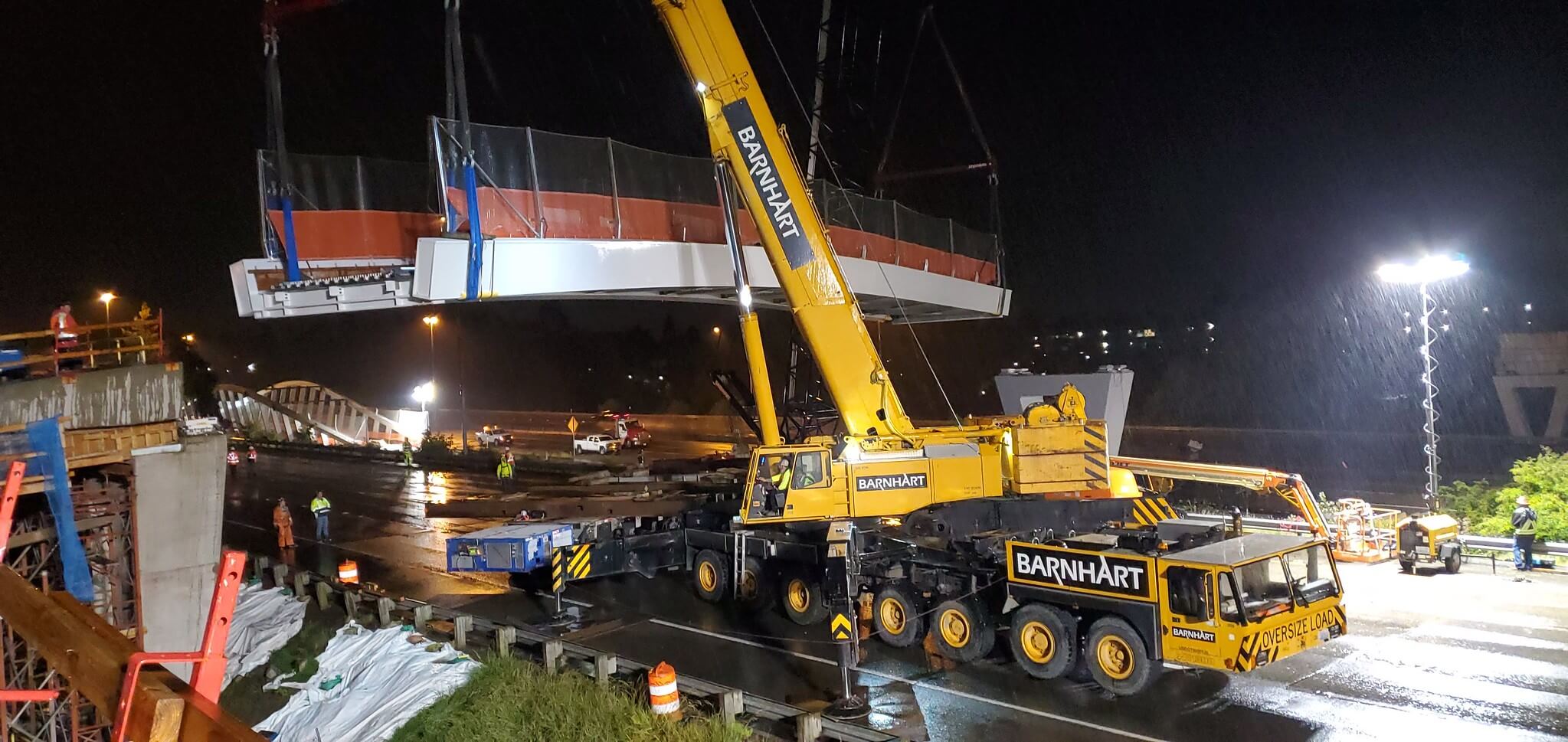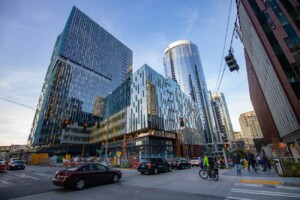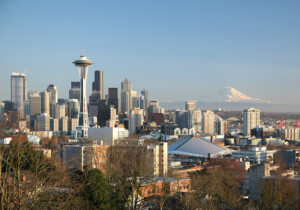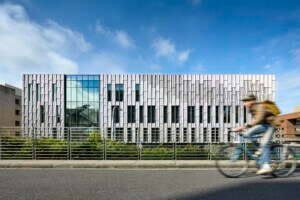In the 1960s, much of the city of Seattle—including both its downtown core and a lively patchwork of residential neighborhoods located directly to the north—was effectively cleaved in half by the construction of Interstate 5, the primary north-south interstate highway on the West Coast. Conditions haven’t changed since, barring the creation of Freeway Park in 1976, an ingenious bit of design that helped reconnect a small stretch of downtown Seattle to the First Hill neighborhood.
Now, a new infrastructural project in the north of the city aims to have a similarly ameliorative impact. Opening on Saturday, October 2, the John Lewis Memorial Bridge for pedestrians and cyclists spans 1,900 feet across ten lanes of freeway to unify the long-estranged neighborhoods of Northgate, lying to the east of I-5, and Licton Springs-North College Park, situated to its west. More specifically, the bridge will link the 62-acre campus of North Seattle College with the Northgate light rail station, which also makes its public debut on Saturday along with two additional new light rail stations to the south, U District and Roosevelt.
While it’s possible to traverse I-5 en route from North Seattle College to the new Northgate light rail station or vice versa by foot, the journey is circuitous, taking as long as 30 minutes to complete. The new bridge, which was named in honor of the late United States congressman and civil rights icon John Lewis this past August (to the chagrin of some), will dramatically reduce travel time between the east and west sides of the freeway. What’s more, according to the Seattle Department of Transportation (SDOT), the structure will “connect the neighborhood’s thriving job and retail centers with the rest of the city and region.”
To that point, the HEWITT-designed Northgate light rail station, which will open to the north of the existing Northgate Transit Center, is shaping up to be a major node in the city. It’s the terminus for Sound Transit’s 4.3-mile Northgate Link extension project, which will connect the Link’s current northern Line 1 terminus at the University of Washington to Northgate. (The line will eventually extend a further 8.5 miles northward to the city of Lynnwood in Snohomish County.) Directly adjacent to the new light rail station and transit center is the former Northgate Mall, which opened in 1950 as one of the country’s first suburban-mall-style shopping centers. Now known as Northgate Station, the mall property is being redeveloped as a 55-acre transient-oriented mixed-use district, complete with retail, housing, commercial office space, and the $80-million Seattle Kraken Community Iceplex, which opened earlier this month.
For community groups and sustainable transportation activists, the John Lewis Memorial Bridge caps off a lengthy campaign for a safe and effective way to traverse I-5 at Northgate by car-free means. The project was first proposed in 2012 and was estimated to cost $20 million. Construction finally kicked off in February 2020, but installation of the freeway-spanning component was delayed until May of this year due to the COVID-19 pandemic. The final section of the span was lifted into place in late June, by which point the project’s cost had ballooned to roughly $56 million.

An earlier bridge scheme prepared by LMN Architects proposed a 2,100-foot-long enclosed tube/truss design with 20-foot-wide walkways, but it was ultimately scrapped due to cost-saving efforts, construction complexities, and other factors. In 2016, SDOT assembled a new project team and the following year unveiled a revised tied-arch bridge design—this one from VIA Architecture (now VIA – A Perkins Eastman Studio, following a July 2021 merger).
As built, the bridge is shorter and features slightly narrower walkways than the earlier iteration. On the plus-side, it offers an “enhanced user experience,” per SDOT, that includes a wetland wildlife overlook near the college and a view of arriving light rails trains at NE 100th St.
SDOT also established a comprehensive Tree Mitigation Plan for the project. The construction of the bridge necessitated that 93 trees be removed; a total of 464 new trees—ones “better suited to the wetland conditions near the bridge” per SDOT—were planted in their place.
“This bridge, named for an American hero, is a victory for bike advocacy, and a victory for community engagement,” said Dee Lambert, executive director of the Cascade Bicycle Club, the largest bicycling nonprofit in Washington, in a statement. “It is a victory for democracy and for all Seattle residents, whose ability to travel without a car has greatly expanded.”
Lambert added that the bridge “only exists because people spoke up, organized, and demanded something more for their community than a colossal parking garage that would have created more traffic congestion, more pollution and more separation at a time when we need to increase the walkability and bikeability of our communities.”
Joining VIA on the larger project design team were: Pacific Bridge (steel span engineering), CivilTech (concrete span engineering), CM Design (civil engineering), Joe Couples Engineering (electrical), Osborn Consulting (drainage), Johnson and Sutherland (landscape design), and HWA GeosSciences (geotechnical design).
A handful of community-based soirées and grand opening events will be held over the weekend, all of them celebrating the coinciding debuts of the John Lewis Memorial Bridge and the three new light rail stations at Northgate, Roosevelt, and in the U District. (In addition to Northgate, HEWITT also designed Roosevelt station while LMN Architects designed the U District station as well as the neighboring University of Washington station, which opened in 2016 as part of the University Link Expansion project.) More details on the festivities can be found here.











